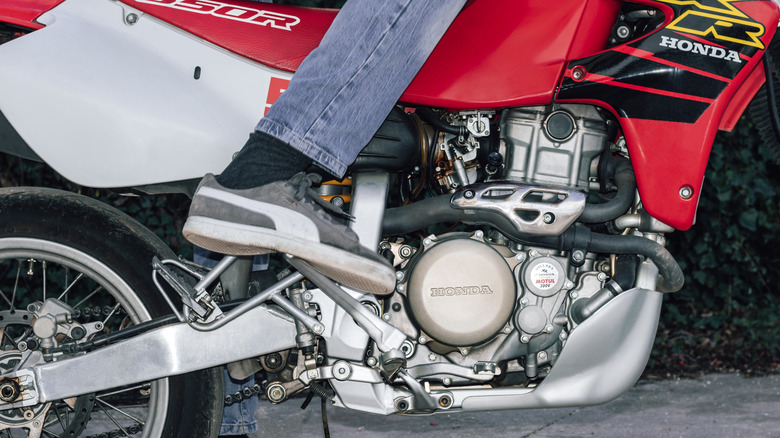Kickstarting A Motorcycle Can Be Dangerous - Here's How To Safely Do It
Some of the most iconic motorcycles of all time don't come equipped with electric starters. If you want to take them for a ride, you will have to start them the old-fashioned way, by kickstarting them. Kickstarting a motorcycle seems straightforward: push the lever down, and the engine fires up. But it's not that simple, and doing it wrong can injure you.
The kickstarter is a direct mechanical link to the engine, and misjudging the compression stroke or not following the right sequence can cause the lever to snap back violently. That kickback is strong enough to sprain an ankle, bruise a shin, or allegedly even break bones. Older bikes without modern safety features like decompression levers or electric starters are the most unforgiving. Riders who are new to vintage motorcycles often underestimate the risk, which is why a motorcycle safety course is always a good idea.
Another danger comes from poor balance. Standing on one foot while forcing the lever down can cause you to slip if the bike isn't on stable ground. A motorcycle tipping over mid-kickstart can pin you underneath or damage the bike. Even seasoned riders have experienced accidents when they got careless or rushed the process. That's why understanding what can go wrong is the first step toward doing it safely. When done properly, kickstarting is reliable. When done wrong, it's an accident waiting to happen.
The right way to kickstart a motorcycle
Safety starts with preparation. Place the motorcycle on level ground, ideally using the center stand if the bike has one. Check that it's in neutral, as attempting to kickstart while in gear can jolt the bike forward unexpectedly. Next, prime the engine. On carbureted models, that usually means turning on the fuel tap and using the choke if it's cold. You'll also need to apply some throttle. Some older motorcycles also benefit from gently pushing the kickstarter through a couple of strokes to move oil into the cylinder.
Stand with your weight evenly distributed when you are ready. Push the kick lever forward until you encounter resistance, which indicates the compression stroke. Stop there, reset the lever to the top, and then deliver a firm, smooth kick all the way down. Keep your foot steady while kicking and avoid any movement that could cause your foot to lose contact, because this will increase the risk of kickback.
Keep your knee slightly bent and let your body weight do most of the work instead of just your leg muscles. After the engine starts, you should ease off the throttle to achieve a stable engine idle. Start the process again from the beginning if the first attempt fails. Note that many motorcycle brands, including Harley-Davidson, have switched to EFI, and these generally don't require kickstarting.
Extra precautions for safe kickstarting
Beyond proper technique, small precautions make kickstarting safer. Always wear sturdy footwear. Thin shoes or sandals leave you vulnerable if the lever snaps back or your foot slips. Boots with ankle support are ideal. Pay attention to your footing, too. Gravel, wet pavement, or uneven surfaces can make you lose balance quickly. On older high-compression bikes, consider using the decompression lever if fitted; it reduces kickback by easing cylinder pressure. Riders should also stay clear of the exhaust side when kickstarting. Many vintage bikes have hot pipes close to the lever, and a slip can burn your leg.
Another overlooked step is keeping bystanders at a safe distance. A bike lurching forward or falling over can injure someone standing nearby. If repeated attempts don't start the engine, avoid overexertion. A tired rider is more likely to kick incorrectly and get hurt. In those cases, recheck the fuel and ignition before trying again.
All in all, kickstarting safely is about controlling risk. When you know how to position yourself, use the right technique, and take precautions, it becomes a dependable method of starting a bike, instead of a hazard.


